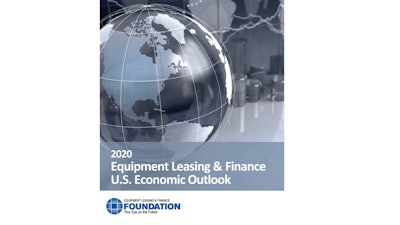
Owing to the substantial uncertainty stemming from both COVID-19 and the impact of social distancing measures on the U.S. economy, investment in equipment and software is projected to contract severely in 2020, to between -8.6% and -13.5%. Similarly, the U.S. economy is expected to have its worst year in decades, with annual growth slowing to between -5% and -9.4%, according to the Q2 update to the 2020 Equipment Leasing & Finance U.S. Economic Outlook released by the Equipment Leasing & Finance Foundation.
While the economy will continue to suffer until the public health crisis is resolved, conditions are expected to improve in the third and fourth quarters, which should produce strong annualized growth rates after a large contraction during the first half of the year. Nonetheless, the economy will be smaller at the end of 2020 than it was at the start.
Scott Thacker, Foundation Chair and Chief Executive Officer of Ivory Consulting Corporation, said, “This edition of the U.S. Economic Outlook clearly shows the COVID-19 impact on the economy. The report portrays in detail how 2020 is likely to be one of the most challenging years in history for the U.S. economy and for our industry. Going into 2020, equipment and software investment was already at its weakest growth level since 2016, and now is expected to plunge to nearly unprecedented low levels of growth. There are a few equipment verticals, however, such as medical devices and computers, that are expected to be more resilient.”
The Q2 update has been redesigned for a more comprehensive and reader-friendly format. Highlights from the report include:
- The U.S. economy is in recession and will undergo a historically deep contraction in the second quarter. However, a timely and well-coordinated policy response of sufficient scale could limit the recession’s long-term effects.
- Capital investment contracted for three consecutive quarters in 2019 and will suffer due to the pandemic. The oil sector is likely to be particularly exposed due to the combination of cratering global demand and a price war.
- The manufacturing sector faces a sharp downturn in 2020, although certain industries critical to public health may see a boost in demand.
- While some Main Street businesses will continue to operate as the country copes with the pandemic, many won’t — and most will suffer. The success of federal efforts to help small businesses stay afloat and avoid widespread layoffs and business failures is critical.
- Prior to the COVID-19 outbreak, consumers were reasonably well-positioned to handle normal fluctuations in economic conditions. However, due to historic job losses, consumer financial stress will likely rise sharply and spending will fall. The CARES Act should help mitigate some of the damage to consumers, although additional federal support will likely be necessary.
The Foundation-Keybridge U.S. Equipment & Software Investment Momentum Monitor, which is released in conjunction with the Economic Outlook, tracks 12 equipment and software investment verticals. In addition, the Momentum Monitor Sector Matrix provides a customized data visualization of current values of each of the 12 verticals based on recent momentum and historical strength. Most equipment verticals will face a difficult investment environment in 2020, though select industries may experience a boost. Over the next three to six months:
- Agriculture machinery investment growth is expected to remain weak.
- Construction machinery investment growth is expected to remain negative.
- Materials handling equipment investment is likely to remain negative.
- All other industrial equipment investment growth is likely to contract.
- Medical equipment investment growth should improve.
- Mining and oilfield machinery investment growth is likely to severely contract.
- Aircraft investment growth should remain negative.
- Ships and boats investment growth is likely to remain weak and may contract.
- Railroad equipment investment growth is likely to decline substantially.
- Trucks investment growth should further weaken and may enter contraction territory.
- Computers investment growth appears set to further strengthen.
- Software investment growth is murky; while the Momentum Monitor signals further weakening, a proliferation of remote working arrangements could provide an unexpected boost.
The full report of the Momentum Monitor is now available at https://www.leasefoundation.org/industry-resources/momentum-monitor/.
The Foundation produces the Equipment Leasing & Finance U.S. Economic Outlook report in partnership with economic and public policy consulting firm Keybridge Research. The annual economic forecast provides the U.S. macroeconomic outlook, credit market conditions, and key economic indicators. The Q2 report is the first update to the 2020 Economic Outlook and will be followed by two more quarterly updates before the publication of the 2021 Economic Outlook in December.
Download the Q2 update report at https://www.leasefoundation.org/industry-resources/u-s-economic-outlook/. All Foundation studies are available for free download from the Foundation’s online library at http://store.leasefoundation.org/.
A free webinar sponsored by the Foundation and the Equipment Leasing and Finance Association, “Coronavirus and the U.S. Economy: Implications for the Equipment Finance Industry,” will be presented on Wednesday, April 15 at 1 p.m. ET. Economists Dr. Robert Wescott and Jeff Jensen of Keybridge will discuss the state of the economy and the equipment finance industry in the face of the global pandemic. For details and to register visit www.elfaonline.org/events/2020/WW041520

















